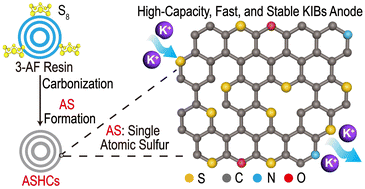Surface-dominated potassium storage enabled by single-atomic sulfur for high-performance K-ion battery anodes†
Abstract
Due to the large size and heavy mass of the K-ion, the pursuit of reliable anodes with outstanding comprehensive performance for K-ion batteries (KIBs) remains a formidable challenge. Typically, high-capacity potassium storage will lead to the electrodes’ serious volumetric expansion and elevated instability. Herein, it is identified that a single-atomic sulfur composite can act as a high-performance KIB anode with an excellent combination of capacity, cyclability, and rate. A high content (∼32 wt%) single-atomic sulfur can be covalently bonded into the carbon lattice of multi-shelled hollow nanospheres via a simple low-temperature pyrolyzation of the selected precursor. The superb redox reactivity of the single-atomic sulfur together with the porous architectures for the resultant S/C composite can not only enable a fast surface-dominated potassium storage but also ensure its structural resilience, thereby achieving high specific capacity together with outstanding rate and impressive cyclability. This study envisions new perspectives on designing high-performance sulfur-based electrodes.



 Please wait while we load your content...
Please wait while we load your content...